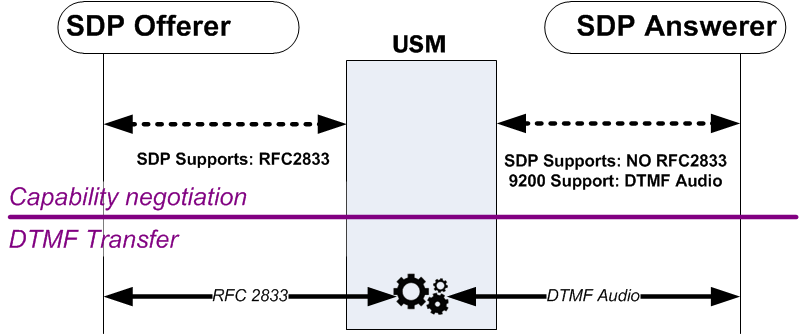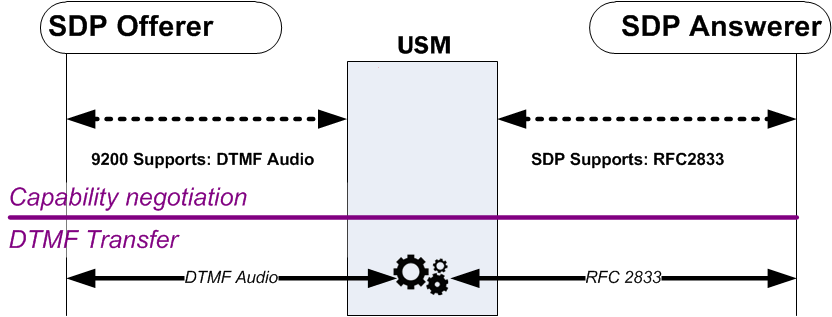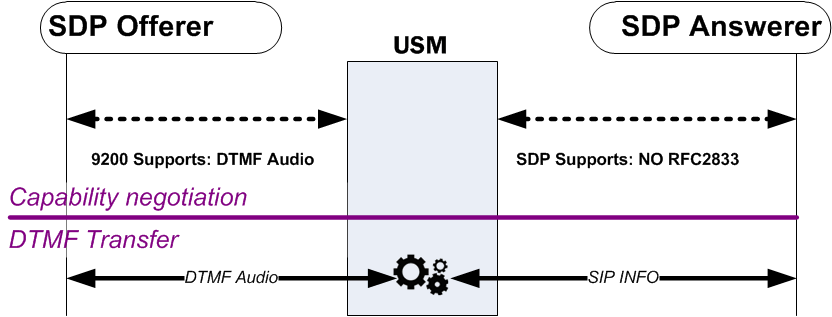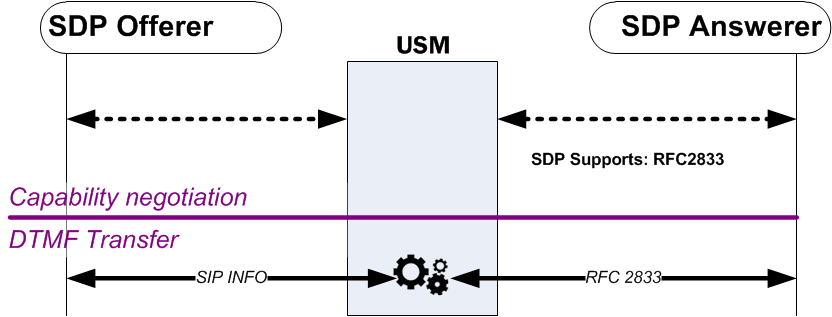Translation Evaluation
After SDP has been negotiated, the Oracle® Enterprise Session Border Controller determines what types of DTMF translation takes place for the call. The Oracle® Enterprise Session Border Controller sequentially evaluates the following rules for each call leg to determine what DTMF indication type it will forward to an endpoint.
RFC 2833 Sent by Offerer
In the following three examples, the SDP offerer sends DTMF indication messages in RFC 2833 format. The SDP answerer can receive DTMF indications in the format identified in each example.
RFC 2833 to RFC 2833
When the SDP offer and answer sides of a call both support RFC 2833, the Oracle® Enterprise Session Border Controller forwards RFC 2833 messages between both sides of the call. No processing is used to transform these DTMF-indication massages to another format.
Note:
When the audio stream is transcoded, DTMF audio is completely removed from the audio stream.
A SIP INFO message received from either the offerer or answerer is forwarded unconverted to the other side of the call.
If there is no audio transcoding enabled for this call, and the egress side is set to dual, a received SIP INFO message will not be converted to both RFC 2833 and SIP INFO messaged for sending to the other side of the call.
If DTMF audio tones are received from either the offerer or answer, they are forwarded unconverted to the other side (when the audio portion of the call is not transcoded).
RFC 2833 to DTMF Audio Tones
When the SDP offer side supports RFC 2833, and the SDP answer side supports the three DTMF Audio Tone conditions and does not support RFC 2833, the Oracle® Enterprise Session Border Controller converts from RFC 2833 to DTMF audio tones for the call.

A SIP INFO message received by the Oracle® Enterprise Session Border Controller from either the offerer or answerer is converted into the DTMF transfer method that the previous diagram shows for the egress side of the message. In this case, transcoding resources are used.
RFC 2833 to SIP INFO
When the SDP offer side supports RFC 2833 and the SDP answer side does not support the DTMF conditions nor RFC 2833, the Oracle® Enterprise Session Border Controller converts from RFC 2833 to SIP INFO.

If a SIP message is received from the offerer, it is forwarded unconverted to the answerer.
DTMF Audio Tones Sent by Offerer
In the following three examples, the SDP offerer sends DTMF indication messages in DTMF audio tones format. The SDP answerer can receive DTMF indications in the format identified in each example.
DTMF Audio to DTMF Audio
If the SDP offer and answer sides both support the same type of G711 codec, the audio stream is forwarded between the two sides without processing.

If the two sides of the call support DTMF audio tones, but use different audio codecs, and the SDP answer side supports the three DTMF Audio Tone conditions and does not support RFC 2833 then the Oracle® Enterprise Session Border Controller will preserve DTMF audio tone indication across the call.
Transcoding resources are used only if different audio codecs are used or the Override Preferred DTMF Audio feature is enabled.
DTMF Audio to RFC 2833
When the SDP offer side supports DTMF audio tones, and the SDP answer side supports RFC 2833, and transcoding resources are available, and does NOT support either or both of the first two DTMF Audio tone conditions, then the Oracle® Enterprise Session Border Controller will convert incoming DTMF audio tones to outgoing RFC 2833 packets.

Transcoding resources are always required in this scenario.
DTMF Audio to SIP
When the SDP offer side supports DTMF audio tones, and the SDP answer side does not support RFC 2833, and does not support the three DTMF Audio Tone conditions, then the Oracle® Enterprise Session Border Controller converts incoming DTMF audio tones to SIP INFOmessages.

Transcoding resources are always required in this scenario.
SIP INFO Sent By Offerer
In the following three examples, the SDP offerer sends DTMF indication messages in SIP INFO message format. The SDP answerer can receive DTMF indications in the format identified in each example.
SIP INFO to RFC 2833
When the SDP offer side sends a SIP INFO message, and the SDP answer side supports RFC 2833, then the Oracle® Enterprise Session Border Controller will convert incoming SIP INFO messages to outgoing RFC 2833 packets.






